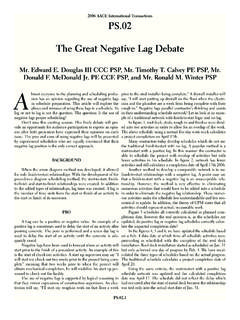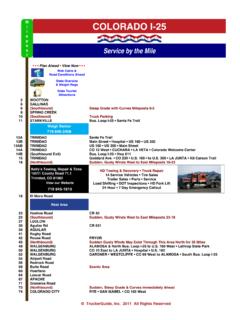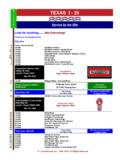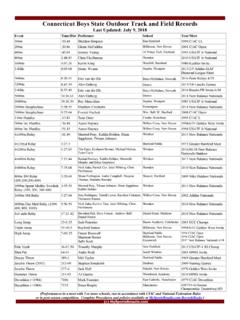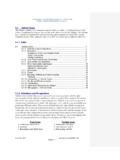Transcription of Measured Mile Labor Analysis - Calvey Consulting LLC
1 2003 AACE International Transactions Measured mile Labor Analysis Timothy T. Calvey , PE, and William R. Zollinger III, PE. P. roductivity, whether it is in manufacturing, white-col- in a productivity index. A productivity index of less than one, lar work, professional sports, or construction, is one of meaning that the actual workhours were greater than the progress the major components distinguishing success from earned workhours, indicated the project was experiencing lower failure. In construction, productivity has become than anticipated productivity. A productivity greater than one, even more important as budgets and time frames are tightened to where the progress earned workhours were greater than the actu- the point of strangulation.
2 As a result, the ability to measure pro- al workhours, indicated work was being performed better than ductivity and to articulate deviations in productivity has become anticipated. essential for the success of businesses involved in the construction The Labor productivity was normally summarized in similar industry. Presently, the most widely accepted evaluation of pro- work activities much like today's specifications. For example, typ- ductivity deviations is the Measured mile method. This paper pro- ically concrete installation activities such as formwork, placement vides a look at the history of Labor productivity and the application of reinforcing steel, installation of embedded metals, placement and acceptance of the Measured mile .
3 Of concrete, and stripping of forms would be summarized under a foundation activity. Table 1 provides a typical calculation. In the example, the work being performed on the footing HISTORY installation had a lower productivity compared to the wall and pier installation. Overall, the concrete work was being preformed During the 1970s, petroleum and chemical companies at a slightly better efficiency ( ) than the standard. Table 2 is (petro-chem) understood the importance of monitoring construc- an example of an in progress report on foundations. tion Labor productivity on their major construction projects. As a Electrical activities such as hanging conduit, pulling wire, result, petro-chem championed a system of monitoring construc- installing fixtures and devices, and terminations would be moni- tion progress against Labor hours expended.
4 In order to service tored as electrical activities. The standard unit rates used to mon- petro-chem requirements, engineering procurement construction itor the progress were in fact usually identical to the unit rates (EPC) companies of that time provided cost engineers and cost used by the estimators, with the possible exception of an adjust- reporting systems for the project. The technique implemented to ment for local Labor factors. The local Labor multiplier is used to measure Labor productivity was a standard workhour system. The adjust for differences in Labor conditions, work schedule and basis for the system developed earlier in Alvin, TX, utilized time unique project complexity issues.
5 By employing the standard studies to develop base workhours for the installation of various workhour Labor productivity method, EPCs were able to measure commodities. These time studies resulted in standard Labor units changes in Labor productivity and exert management controls to for installation of commodities such as reinforcing steel, concrete, mitigate losses. Further, a project was able to evaluate Labor pro- structural steel, process piping, and electrical conduit and cable. ductivity on foundations compared to Labor productivity on erect- Petro-chem and EPC estimating departments expanded the ing steel or Labor productivity on installing electrical components. standard Labor units to include a multitude of Labor functions such All work activities were weighted in accordance with their stan- as equipment setting and alignment, welding, instrumentation dard workhour component.
6 And controls. The standard hours were based on the work being During the period from 1970-1990, it was quite common to performed under certain conditions such as a 40-hour workweek, have 4-6 cost engineers providing monthly Labor reports on proj- unobstructed access to the job site, moderate temperatures, etc. In ects $100M-$200M in value. However, economic pressures have order to quantify the standard workhours earned on a project at a forced EPCs, as well as others, to reduce field staffing, and in given point in time, cost engineers would perform physical sur- many cases, eliminate cost engineers who provide full time quan- veys and calculate the quantity of commodities installed.
7 The tity surveys. In their place, other methods have been established quantity installed was then multiplied by the standard unit work- for measuring Labor productivity that are very similar to the origi- hour factor for that commodity to develop the workhours earned. nal standard workhour method. As a starting point, let us examine The earned workhours were then compared to the actual work- how a typical contractor develops its lump sum price. hours expended installing the commodity. In most cases, the Most contractors use standard units similar to those identified earned workhours were divided by the actual workhours, resulting by an estimating service such as Richardson or Means, or often 2003 AACE International Transactions Table 1.
8 Earned Quantity Standard Actual Activity Unit Standard Productivity Installed Unit Rate Man hours Man hours Footings Set and Strip Forms Sf Reinforcing Steel Cwt Embedded Metal - Pour Concrete Cy Subtotal Footing Wall & Piers Set and Strip Forms Sf Reinforcing Steel Cwt Embedded Metal Cwt Pour Concrete Cy Subtotal Walls & Piers Total Concrete refer to contractor associations such as the National Electrical project on a monthly basis. This percent complete is in fact based Contractors Association (NECA) or the Mechanical Contractors on the estimate weighting. Association (MCA) for standard units, which are then adjusted On a monthly basis, the contractor will have a Labor report based on the contractor's historical database.
9 Just as EPCs, con- that provides workhour expenditures on the project. The work- tractors perform rigorous takeoffs of design drawings to determine hour expenditures can be compared to the percent of Labor their quantities and multiply those quantities by the standard progress earned. It is recommended that the noncontributing units. The resultant workhours are then multiplied by a dollar rate Labor such as nonworking general foreman or supervisory staff be to include Labor payroll, taxes, insurance, fringe benefits, and asso- removed in order to enhance the Labor productivity measurement. ciated overhead and profit. In a similar manner, contractors use Table 4 is an example of the workhour comparison of percent the quantity takeoff to obtain vendor quotes and unit prices for progress versus actual workhours.
10 Material needs and then mark them up for associated overhead Another important element is to crosscheck the quantities and profit. The two are combined, and the overall price is sub- used in the estimate/pay application breakdown against actual mitted. If it is deemed that the bid is the lowest and best price, the quantities in order to identify any significant variances from the contractor is awarded the contract. Following the award, the con- estimate. Major variances should be adjusted before the calcula- tractor submits to the architect a price breakdown of the project tion. Also check to determine that the estimated units are in fact for the pay application. The contractor develops this breakdown proportional to normal standards.
